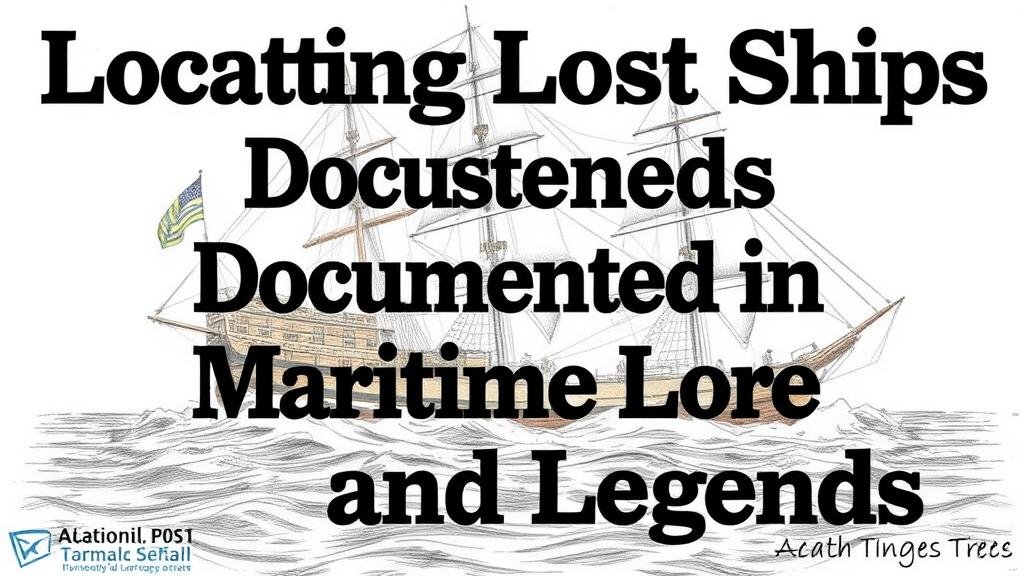Locating Lost Ships Documented in Maritime Lore and Legends
Locating Lost Ships Documented in Maritime Lore and Legends
The sea has always captivated humanity, serving as both a pathway and a harbinger of stories that traverse generations. Among these maritime tales are accounts of lost ships–vessels shrouded in mystery, folklore, and legends. This article explores the historical significance of these ships, the methodologies for their discovery, and illustrates the confluence of myth and maritime exploration through concrete examples and case studies.
The Historical Context of Lost Ships
Throughout history, oceans have claimed numerous ships, leading them to become part of folklore and legend. Notable examples include the RMS Titanic, the USS Indianapolis, and the Flying Dutchman, each carrying with it a narrative that transcends mere shipwreck. The Titanic, for instance, remains a symbol of human hubris and technological failure, while the Flying Dutchman embodies superstitions regarding doomed seafaring expeditions.
According to maritime historians, more than 3 million shipwrecks are estimated to rest on the ocean floor. This vast number speaks to the perilous nature of sea travel, especially during the age of exploration. Documented accounts, such as those by the ancient Greeks and Romans, talk of ships that vanished under mysterious circumstances, contributing to the rich tapestry of maritime lore.
Methodologies for Locating Lost Ships
Locating lost ships involves a combination of historical research, archaeological techniques, and modern technology. The following methodologies are typically employed:
- Archival Research: Examining historical documents, logs, and mariner accounts provides essential context and clues. For example, the successful discovery of the USS Indianapolis relied heavily on the meticulous records kept during World War II, which detailed the ships last known position.
- Sonar and Remote Sensing: Technologies such as Side-scan sonar and multi-beam sonar facilitate underwater mapping, allowing researchers to identify potential wreck sites. In 2018, a private expedition used advanced sonar techniques to locate the wreck of the USS West Virginia sunk during the Pearl Harbor attack.
- Submersible Exploration: Deep-sea vehicles are deployed to explore underwater sites that sonar technology identifies. The exploration of the Titanic wreck by the submersible DSV Alvin demonstrated how direct observation can yield invaluable artifacts, fostering a deeper understanding of the ship’s last voyage.
Case Studies: Maritime Lore Meets Modern Discovery
Several case studies illustrate the effective application of both myth and technology in locating lost ships:
The Mary Celeste
The Mary Celeste, a merchant brigantine found adrift in 1872, has become a cornerstone of maritime mystery. The ship’s crew disappeared without a trace, leading to numerous theories ranging from pirate attacks to supernatural phenomena. Recent underwater explorations have suggested that the ship may have been abandoned following a possible mutiny influenced by alcohol–a theory supported by the condition of the ship and contents found aboard.
The Whydah Gally
The Whydah, a pirate ship that sank off the coast of Cape Cod in 1717, is a prime example of successful treasure recovery. Discovered by underwater explorer Barry Clifford, the shipwreck yielded millions in artifacts, providing insight into pirate culture and shipbuilding techniques of the time. The Whydahs recovery illustrates how legends can lead to tangible archaeological findings and enhance our understanding of maritime history.
Challenges in Locating Lost Ships
Despite advances in technology, locating lost ships is fraught with challenges:
- Environmental Factors: Ocean currents, sedimentation, and weather conditions can obscure wreck sites. For example, the search for the German battleship Bismarck faced significant hurdles due to the depth and complexity of the underwater terrain.
- Legal and Ethical Considerations: Often, shipwrecks are considered gravesites, leading to ethical debates regarding salvage rights and the treatment of discovered artifacts. The Titanic wreck has been subjected to strict preservation guidelines due to its significance as a maritime memorial.
Conclusion and Actionable Takeaways
Locating lost ships is a fascinating interplay between myth and reality, combining historical narratives with modern scientific techniques. The efforts to unearth these seafaring mysteries not only enrich our cultural understanding but also provide critical insights into human behavior and technological advancement.
For those interested in maritime exploration, consider the following actionable takeaways:
- Engage in archival research: Dive into local libraries, maritime museums, and online databases to uncover various shipwreck narratives.
- Explore technology: Familiarize yourself with the technology behind underwater exploration and learn about opportunities to participate in expeditions or volunteer for research projects.
- Advocate for preservation: Support advocacy groups that promote the respectful treatment of shipwreck sites and celebrate the history they represent.
By embracing the stories and challenges associated with lost ships, we contribute not only to the preservation of maritime lore but also to the collective memory of humanity’s relationship with the sea.


